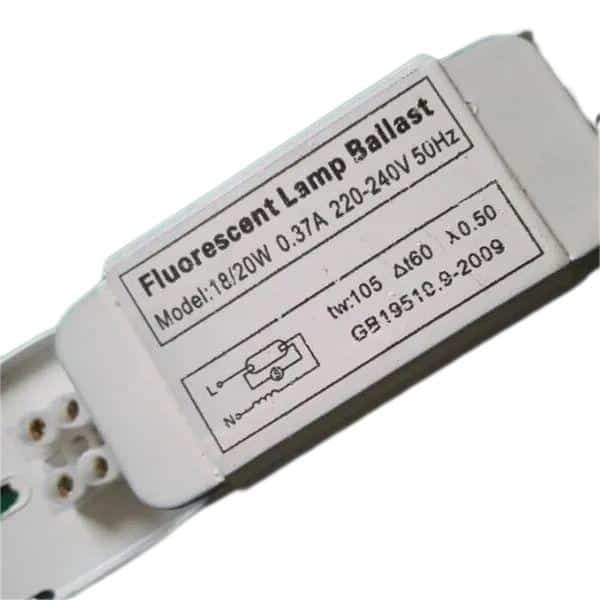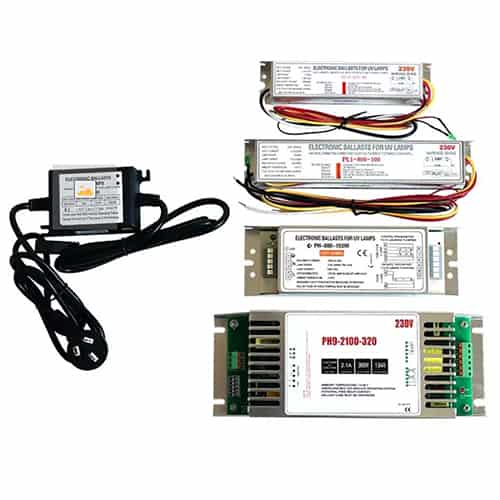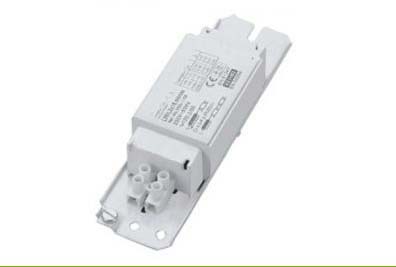Fluorescent lights need a ballast to make sure the electricity going through them is controlled. Without a ballast, the bulb would get too hot and burn out, which could be a safety problem. The fluorescent light ballast controls the electricity going through the bulb to make sure the light works well and is safe.
Fluorescent light bulbs need a ballast to control the electricity and give them a little electrical push to get started. The ballast makes sure the electricity going into the bulb is steady and doesn’t make the bulb get too hot and burn out.
To understand how important a ballast is, you need to know how fluorescent lights work and what the ballast does to make them work.
What is a Ballast?
A ballast is an electrical device designed to regulate the current that passes through a fluorescent lamp. When the light is first switched on, the ballast provides a high voltage to start the lamp. Once the lamp is running, it then reduces and stabilizes the voltage to a safe level to maintain steady illumination without damaging the lamp.
Fluorescent lamps work differently from traditional incandescent bulbs, which do not need ballasts. Incandescent lamps can handle the steady flow of current directly from a power source. However, fluorescent lamps, due to their gas-discharge lighting technology, need current regulation. Without a ballast, the lamp would experience an uncontrolled current surge, leading to overheating and immediate burnout.
The ballast functions as a safeguard, ensuring that the current stays within a safe range and that the lamp operates efficiently without damage.
How Fluorescent Light Bulbs Work
Fluorescent lamps operate by exciting mercury vapor inside the tube, which then generates ultraviolet (UV) light. This UV light is not visible to the human eye, but it excites a phosphor coating on the inside of the tube, causing the phosphor to emit visible light.
To start this process, the lamp requires an electrical arc to form between two electrodes inside the tube. The ballast provides the necessary high voltage to initiate this arc, which is significantly higher than the voltage required for the lamp’s normal operation.
Once the arc is established, the gas inside the tube becomes ionized, and current flows more easily. At this point, the voltage needs to drop to prevent the lamp from overheating. The ballast is responsible for this transition. It limits the current and stabilizes the flow, ensuring that the lamp operates steadily and safely for its entire lifespan.
The Role of the Ballast in Fluorescent Lamps
The primary function of the ballast is to regulate voltage and current. When you flip the switch to turn on a fluorescent lamp, the ballast briefly supplies a high starting voltage to ignite the arc inside the tube. After the lamp starts, the ballast reduces the voltage and ensures a stable current to keep the lamp illuminated without overheating.
Without a ballast, the initial surge of electricity required to start the lamp would cause it to draw far too much current, resulting in overheating, damage to the lamp’s components, and an extremely short lifespan. By controlling the flow of electricity, the ballast prevents these issues and allows the lamp to work properly.
Additionally, modern ballasts often improve the energy efficiency of the lamp, making them essential components for both safety and performance.
Different Types of Ballasts for Fluorescent Lighting
There are two primary types of ballasts used in fluorescent lighting: magnetic ballasts and electronic ballasts. Each has unique characteristics that affect the lamp’s performance, efficiency, and cost.
Magnetic Ballasts
Magnetic ballasts, also known as core-and-coil ballasts, were the original ballast technology used in fluorescent lighting systems. These ballasts use a simple design based on electromagnetism to regulate the current. Inside the ballast, a copper or aluminum coil is wrapped around a metal core. This creates a magnetic field that helps control the voltage and current passing through the fluorescent tube.
While magnetic ballasts are reliable, they have some drawbacks. They tend to be bulky, generate heat, and produce an audible hum when in operation. They can also cause the light to flicker, especially as the lamp ages. Because of these inefficiencies, magnetic ballasts are gradually being phased out in favor of more modern alternatives.
Electronic Ballasts
Electronic ballasts represent the next generation of ballast technology. Unlike magnetic ballasts, which operate at the same frequency as the electrical grid (usually 50 or 60 Hz), electronic ballasts operate at a much higher frequency, typically in the range of 20,000 Hz. This higher frequency eliminates the flickering and humming associated with magnetic ballasts and allows for faster startup times.
Electronic ballasts are much more energy-efficient than their magnetic counterparts, making them a popular choice in modern lighting systems. They also allow for features like dimming and more precise control over light output, which can lead to significant energy savings over time.
Because of these advantages, electronic ballasts are now the standard in many commercial and residential fluorescent lighting systems.
Magnetic vs. Electronic Ballasts: Key Differences
When comparing magnetic and electronic ballasts, several key differences stand out:
- Efficiency: Electronic ballasts are significantly more efficient than magnetic ballasts. They reduce energy consumption, improve the light quality, and often extend the lifespan of the fluorescent tube.
- Startup Time: Magnetic ballasts often require a delay for the lamp to warm up and achieve full brightness. In contrast, electronic ballasts provide nearly instant lighting without flickering.
- Noise: Magnetic ballasts can be noisy, producing a humming sound during operation. Electronic ballasts, on the other hand, operate silently.
- Flickering: Magnetic ballasts tend to cause noticeable flickering, especially as the fluorescent tube ages. Electronic ballasts, due to their higher operating frequency, produce steady, flicker-free light.
While magnetic ballasts are still used in some applications, particularly in older systems, electronic ballasts are the preferred choice for new installations due to their superior performance and efficiency.
Why Fluorescent Lamps Need Ballasts for Safe Operation
Fluorescent lamps require ballasts for several important reasons. First and foremost, ballasts provide the necessary control over electrical current to prevent damage to the lamp. When a fluorescent lamp starts, it needs a higher voltage than during regular operation. The ballast regulates this starting voltage and then limits the current once the lamp is running.
Ballasts also play a crucial role in extending the lifespan of fluorescent lamps. By preventing electrical overload, the ballast ensures that the lamp doesn’t draw more current than necessary, which would otherwise lead to overheating and premature burnout. Additionally, ballasts help to stabilize the light output, ensuring a consistent and reliable performance throughout the lamp’s life.
Common Issues When a Ballast Fails
When a ballast begins to fail, it can cause several noticeable issues. Common symptoms include flickering lights, buzzing noises, and a delayed start when turning on the lamp. In some cases, the lamp may not turn on at all, or it may burn out prematurely.
Replacing a faulty ballast is usually the best solution. While magnetic ballasts tend to degrade over time, electronic ballasts typically last longer but can still experience failure due to factors such as power surges or overheating. Regular maintenance and timely replacement of ballasts can help avoid costly downtime and ensure that lighting systems function optimally.
How Ballasts Contribute to Energy Efficiency
Modern electronic ballasts are designed with energy efficiency in mind. They reduce the amount of power consumed by fluorescent lamps, leading to lower electricity bills and a smaller carbon footprint. In fact, upgrading from older magnetic ballasts to electronic ones can result in significant energy savings over time.
Many electronic ballasts also allow for dimming capabilities, which provides even greater control over energy usage. This makes them a popular choice in offices, schools, and other commercial spaces where lighting needs vary throughout the day.
Final Words
Light ballasts are important parts of fluorescent lighting systems. They make sure the lights work safely, don’t get too hot, and use less electricity. Whether you have a magnetic ballast or an electronic ballast, they both control the electricity going through the bulb to make sure it works well and lasts a long time.





